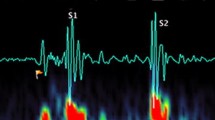Abstract
The authors propose a simulated first heart sound (S1) signal that can be used as a reference signal to evaluate the accuracy of time-frequency representation techniques for studying multicomponent signals. The composition of this simulated S1 is based on the hypothesis that an S1 recorded on the thorax over the apical area of the heart is composed of constant frequency vibrations from the mitral valve and a frequency modulated vibration from the myocardium. Essentially, the simulated S1 consists of a valvular component and a myocardial component. The valvular component is modelled as two exponentially decaying sinusoids of 50 Hz and 150 Hz and the myocardial component is modelled by a frequency modulated wave between 20 Hz and 100 Hz. The study shows that the simulated S1 has temporal and spectral characteristics similar to S1 recorded in humans and dogs. It also shows that the spectrogram cannot resolve the three components of the simulated S1. It is concluded that it is necessary to search for a better time-frequency representation technique for studying the time-frequency distribution of multicomponent signals such as the simulated S1.
Similar content being viewed by others
References
Barry D. T. (1990): ‘Acoustic signals from skeletal muscle,’Am. Physiol. Soc.,5, pp. 17–21
Barry, D. T. (1991): ‘Muscle sounds from evoked twitches in the hand,’Arch. Phys. Med. Rehab.,72, pp. 573–575
Barry D. T. andCole N. M. (1990): ‘Muscle sounds are emitted at the resonant frequencies of skeletal muscle,’IEEE Trans. Biomed. Eng.,37, pp. 525–531
Bedi R., McDonnell J. T. E. andFox K. A. A. (1994): ‘Acoustic analysis of Carpentier-Edwards bioprosthetic heart valves,’Proc. 16th Annual International Conf. IEEE Eng. Med. Biol. Soc., Vol.2, pp. 1284–1285
Chen, D., Durand, L.-G., Guo, Z., andLee, H. C. (1997a): ‘Time-frequency analysis of the first heart sound. Part 2: An appropriate time-frequency representation technique,’Med. Biol. Eng. Comput.,35, pp. 00–00
Chen, D., Durand, L.-G., Guo, Z. andLee, H. C. (1997b): ‘Time-frequency analysis of the first heart sound. Part 3: Application,’Med. Biol. Eng. Comput.,35, pp. 00–00
Cloutier G., Grenier M. C., Guardo R. andDurand L. G. (1987): ‘Spectral analysis of closing sounds produced by Ionescu-Shiley bioprosthetic aortic heart valves. Part 2: Computer simulation of aortic closing sounds and estimation of their truncation level and signal-to-noise ratio,’Med. Biol. Eng. Comput.,25, pp. 492–496
Cohen, L. (1989): ‘Time-frequency distributions—a review,’Proc. IEEE,77, pp. 941–981
Durand, L. G. andGuardo R. (1982): ‘A model of the heart-thorax acoustic system’in Schwartz M.D. (Ed.): ‘Applications of computers in medicine’ (IEEE Eng. Med. Biol. Soc.), pp 29–41
Durand, L. G., Genest J. Jr. andGuardo R. (1985): ‘Modeling of the transfer function of the heart-thorax acoustic system in dogs,’IEEE Trans. Biomed. Eng.,32, pp. 592–601
Durand L. G. andPibarot P. (1995): ‘Digital signal processing of the phonocardiogram: review of the most recent advancements,’CRC Critical Reviews Biomed Eng.,23, pp. 163–219
Hlawatsch F. andBoudreaux-Bartels G. F. (1992): ‘Linear and quadratic time-frequency signal representation,’IEEE Signal Process. Mag., pp. 21–67
Köymen H., Altay B. K. andIder Y. Z. (1987): ‘A study of prosthetic heart valve sounds,’IEEE Trans. Biomed. Eng.,34, pp. 853–863
Leatham A. (1975): ‘Auscultation of the heart and phonocardiography,’ (Churchill Livingstone), pp. 1–178
Luisada A. A., MacCanon D. M., Coleman B. andFeigen L. P. (1971): ‘New studies on the first heart sound,’Am. J. Cardiol.,28, pp. 140–149
Luisada A. A. (1972): ‘The sounds of the normal heart’ (Warren H. Green, Inc.), pp. 1–247
Rangayyan R. M. andLeihner, R. J. (1988): ‘Phonocardiogram signal analysis: A review,’CRC Critical Reviews Biomed. Eng.,15, pp. 211–236
Rushmer R. F. (1952): ‘Cardiovascular dynamics’ (W.B. Saunders Company), pp. 1–567
Sava H. P. andMcDonnell J. T. E. (1994): ‘New analysis-synthesis of first heart sounds using forward-backward overdetermined Prony's method,’ Proc. 16th Annual International Conf. IEEE Eng. Med. Biol. Soc.,2, pp. 1274–1275
Sava H. P., McDonnell J. T. E. andFox K. A. A. (1994): ‘Spectral analysis of first and second heart sounds before and after mechanical heart valve implantation,’ Proc. 16th Annual International Conf. IEEE Eng. Med. Biol. Soc.,2, pp. 1280–1281
Tang, Y., Danmin C. andDurand L. G. (1992): ‘The synthesis of the aortic valve closure sound of the dog by the mean filter of forward and backward predictor,’IEEE Trans. Biomed. Eng.,39, pp. 1–8
Tilkian A. G. andBoudreau Conover M. (1984): ‘Understanding heart sounds and murmurs with an introduction to lung sounds’ (W.B. Saunders Company), pp. 1–265
Wood J. C., Buda A. J., Lim M. J. andBarry D. T. (1991): ‘Spatial variation of first heart sound frequency dynamics across the canine left ventricle: a comparison of intracardiac and epicardial recordings. Proc 13th Annual International Conf. IEEE Eng. Med. Biol. Soc.,13, pp. 2099–2100
Wood J. C., Buda A. J. andBarry D. T. (1992): ‘Time-frequency transforms: A new approach to first heart sound frequency dynamics,’IEEE Trans. Biomed. Eng.,39, pp. 730–740
Wood J. C. andBarry D. T. (1994): ‘Quantification of first heart sound frequency dynamics across the human chest wall,’Med. Biol. Eng. Comput.,32, pp. S71-S78
Wood J. C., Festen M. P., Lim M. J., Buda A. J. andBarry D. T. (1994): ‘Regional effects of myocardial ischemia on epicardially recorded canine first heart sounds,’J. Appl. Physiol.,76, pp. 291–302
Yoganathan A. P., Gupta R., Udwadia F. E., Miller J. W., Ccorcoran W. H., Sarma R., Johnson J. L. andBing R. J. (1976): ‘Use of the fast Fourier transform for frequency analysis of the first heart sound in normal man,’Med. Biol. Eng.,14, pp. 69–73
Author information
Authors and Affiliations
Rights and permissions
About this article
Cite this article
Chen, D., Durand, L.G. & Lee, H.C. Time-frequency analysis of the first heart sound. Part 1: Simulation and analysis. Med. Biol. Eng. Comput. 35, 306–310 (1997). https://doi.org/10.1007/BF02534081
Received:
Accepted:
Issue Date:
DOI: https://doi.org/10.1007/BF02534081




